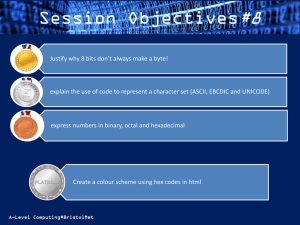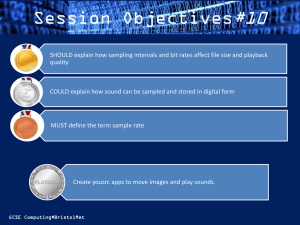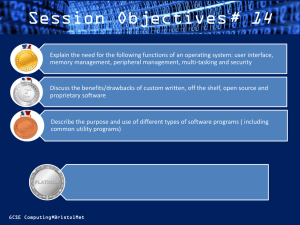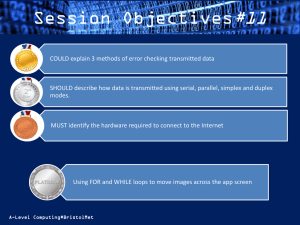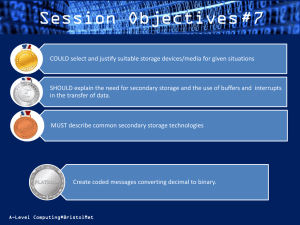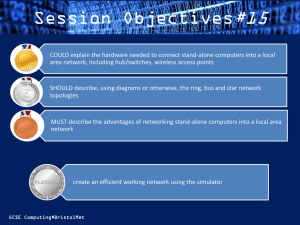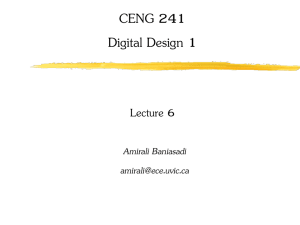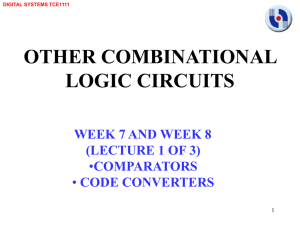ALevelComputing_Session9
advertisement
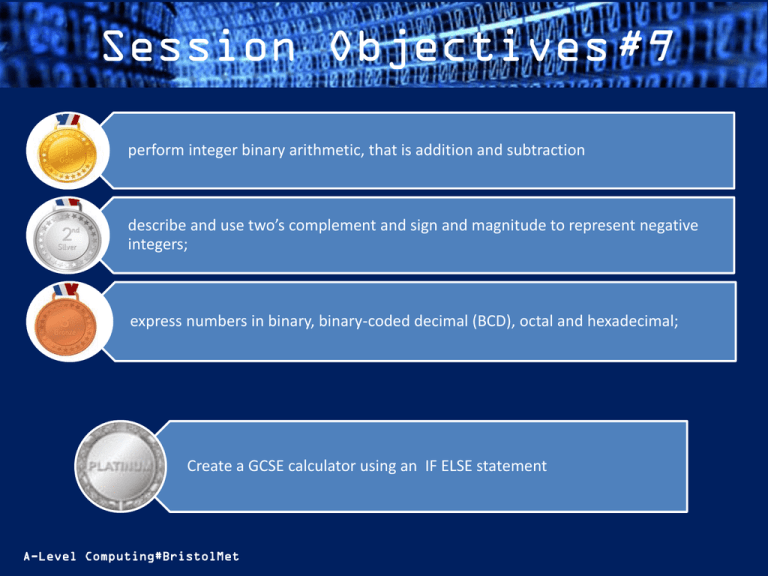
Session Objectives#9 perform integer binary arithmetic, that is addition and subtraction describe and use two’s complement and sign and magnitude to represent negative integers; express numbers in binary, binary-coded decimal (BCD), octal and hexadecimal; Create a GCSE calculator using an IF ELSE statement A-Level Computing#BristolMet Binary Arithmetic & BCD Starter: How many binary digits would be required for this hexadecimal code and what is the 8 bit binary equivalent: #FF9B22 A-Level Computing#BristolMet Converting Binary to Hexadecimal Denary 45 in binary is 32 + 8 + 4 + 1 or 128 0 64 0 32 1 16 0 8 1 4 1 2 0 1 1 Split into 2 nibbles and treated as 4 bits each: 8 0 4 2 1 0 1 0 = 2 8 1 = 4 2 1 0 = 13 1 1 2D TASK: Using the same method convert a) 11101011 b) 10100011 a) EB Now try the reverse, convert to binary a) A5 b) A3 b) 3B a) 10100101 b)00111011 GCSE Computing#BristolMet Binary Coded Decimal (BCD) Binary Coded Decimal (BCD) uses 4 bit binary to represent decimal digits 0 – 9. You simply split example, decimal 7 = 8 4 0 1 the digits and treat the separately. For 75 in BCD is as follows: 5 = 2 1 8 4 2 1 1 1 0 1 0 1 Therefore 75 in BCD becomes: 01110101 Now convert the following denary into BCD: a) 39 b) 58 c) 97 A-Level Computing#BristolMet Binary Arithmetic Another reason why computers are designed to use binary is that addition is so simple in binary. In binary there are only 4 sums which need to be known: 0 0 1 1 + + + + 0 1 0 1 = = = = 0 1 1 0, carry 1 For example; 75 = 0 1 0 0 + 14 = 0 0 0 0 0 1 0 1 Carry 1 1 0 1 1 1 1 1 0 1 0 0 1 = 89 1 1 A-Level Computing#BristolMet Now try: a) 01101101 + 01110001 b) 01111000 + 00110011 Sign & Magnitude So far we have learned how to store positive whole numbers in binary but there is a need to use negative numbers and fractions. You will remember that only 7 bits is need to represent the ASCII character set (127 characters) and this is the purpose of the 8th bit, to represent a +/For example: +/- 64 32 16 +75 = 0 1 0 0 8 1 4 0 2 1 1 1 -75 = 1 1 0 1 1 1 0 0 This is called sign/magnitude representation – the byte is in 2 parts, the sign (+/-) and the size of the number. A-Level Computing#BristolMet 2s Complement There are 2 problems with sign & magnitude representation. Firstly, the biggest number that can be represented is now halved – 127 instead of 255. Secondly, arithmetic now made more complicated as different bits means different things. A solution to this is using a system called 2s complement – the last bit stands for -128. So the diagram looks like this: -128 64 32 16 8 4 2 1 So -75 in 2s complement is: -128 64 32 16 -75 = 1 0 1 1 A-Level Computing#BristolMet 8 4 2 1 0 1 0 1 Subtraction in binary Now using 2s complement subtraction is easier because 75 – 14 is the same as 75 + (-14) -128 75 = 0 -14 = 1 0 Carry 1 64 1 1 0 32 1 1 1 16 0 1 1 8 4 2 1 1 0 1 1 0 0 1 0 1 1 0 1 1 = 61 Now attempt a) 97 + 23 b) 43 – 58 Some more examples:Click Here Why binary arithmetic – Watch this video A-Level Computing#BristolMet
